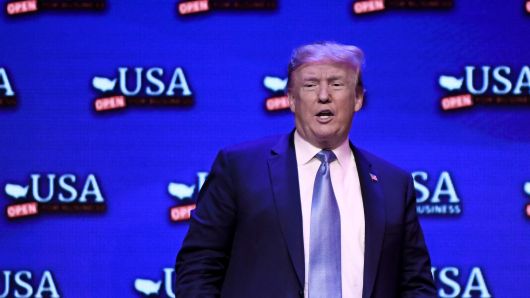
Despite jangled nerves over the increasing potential for a global trade war, domestic stocks are outperforming their global counterparts, suggesting the U.S. has the least to lose should the conflict escalate.
As major U.S. indexes notched losses of 1 percent or more Monday, others around the world got slammed as well. The Hang Seng in Hong Kong edged nearer to the brink of an outright bear market, while the German, French and broad European indexes all posted severe drops.
For much of the year as President Donald Trump has continued to saber rattle about tariffs against Chinese and European goods crossing the U.S. border, domestic stocks have outperformed. While the economic brinkmanship has tamped down returns compared with 2017’s robust market, the U.S. climate remains mostly constructive.
“So far stateside equity and bond markets have shown a relatively sanguine stance amidst escalating trade tension. This has been reflected in a resilience of the US markets as trade issues garner increasing investor attention,” John Stoltzfus, chief investment strategist at Oppenheimer Asset Management, said in a note. “Stateside the economic expansion continues to appear sustainable and expectations for a good Q2 earnings season remain in place. These factors continue to provide positive offset to concerns about trade.”
The S&P 500 has managed to scratch out a 4 percent gain year to date (as of Friday) despite the peaks and valleys of how the trade negotiations have transpired. When comparing exchange-traded funds that track major country indexes, no other developed nation has topped the U.S., with France coming closest at a 1 percent or so return, according to Bespoke Investment Management.
There’s reason to believe that the U.S. has more to gain than lose, at least in a macro sense, from a protracted trade battle.
Trade agreements implemented since the early 1990s — around the time NAFTA came into being — add about 0.2 percent a year to U.S. GDP, according to Societe Generale. Any reversal, then, would have a “modest impact” on the economy, the firm’s economists said.
For investors, then it’s a matter of calibrating risks and developing an appropriate response.
The market needs to figure it out,” said Quincy Krosby, chief market strategist at Prudential Financial. “There will be pockets of investment opportunities. The broad question is, if this does materialize, does it negate the benefits from the tax cuts in terms of the economy?”
To be sure, there are worries that the trade issues indeed will reverse the economic enthusiasm from the historic tax reform Congress passed in December. Bank of America Merrill Lynch economists said recently that a worst-case trade war threatens to push the global economy into a “full-blown recession.”
Indeed, looking at the broad U.S. market doesn’t paint a complete picture. All of this year’s net gain has been technology driven. An ETF that excludes the sector from returns, the ProShares S&P 500 Ex-Technology, is flat for 2018.
However, even in the case of a recession, investors tend to find ways to make money. After all, recessions have not always meant bear markets, and in an economy where corporate profits continue to surge and interest rates remain relatively low, opportunities will present themselves.
Looking for opportunities
Outside of equities, corporate bonds are finding some favor. Marilyn Cohen, president of Envision Capital Management, said the search for yield is taking investors toward higher-quality municipals, which have a default rate near zero and now are carrying yields approaching 4 percent.
“As day follows night, we will get to a certain point in the interest rate market where it’s going to slow everything down economically,” Cohen said, referring to the Fed’s continued rate hikes. “We are either going to slow down or go into recession. But are we there yet? It doesn’t feel like it.”
Stocks at some point could start to feel some pressure from those rising yields.
Virtually every duration of government debt from the three-month bill on up is topping the S&P 500’s current dividend yield of 1.84 percent, providing some incentive to buy-and-hold coupon clippers in the fixed income market. That generally means institutional investors.
The idea that “there is no alternative to equities is being challenged at a time when equities are going nowhere, bond prices are falling and volatility is elevated,” said Michael Arone, chief investment strategist at State Street Global Advisors. “For the first time in a long time, stocks have competition from some of these short-term more conservative and less risky investments.”
Arone is advising investors to prepare for a changing environment, meaning allocations not away from U.S. stocks but toward sectors like energy, materials and commodities.
Oppenheimer’s Stoltzfus said investors shouldn’t get caught up in the trade hype and instead should focus on the bigger picture.
“We continue to believe that movement toward resolution of what is currently an ongoing stand-off and shout out on international trade is more likely to come sooner than later,” he said. “We expect as we have previously said that investor patience will be rewarded, as will we believe, keeping an eye out for opportunities that are likely to develop along the way.”

